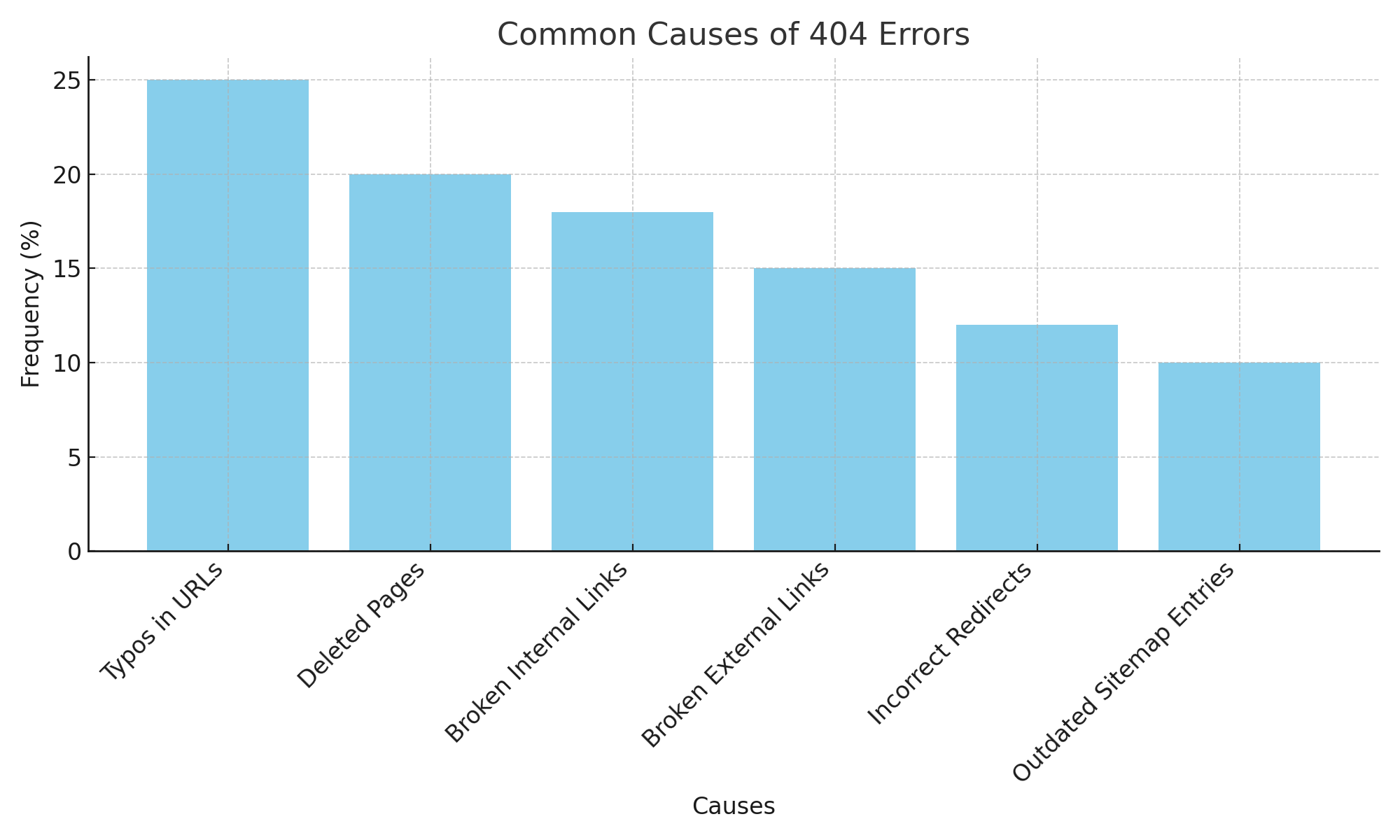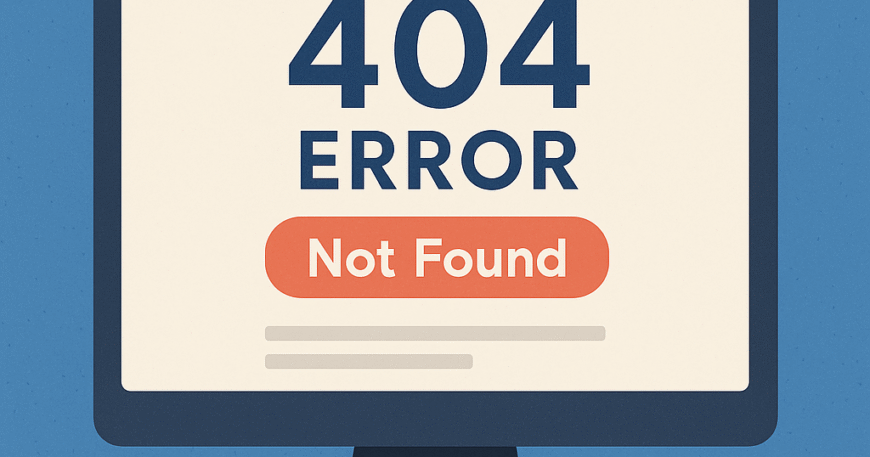Top 10 Smart Solutions for Fixing 404 Errors Quickly and Effectively
Introduction to 404 Errors
What is a 404 Error?
A 404 error occurs when a browser requests a webpage that the server can’t find. It means that the page either never existed, has been moved, or was deleted without proper redirection. This is typically shown as:

While it might seem like a minor inconvenience, it can frustrate users and affect your site’s credibility.
Common Causes of 404 Errors
Here are some of the most frequent causes:
- Typing errors in the URL
- Deleted or moved web pages
- Broken internal or external links
- Incorrect redirects
- Server configuration changes
- Outdated sitemap entries

Understanding the root cause is the first step to fixing 404 errors properly.
Why Fixing 404 Errors Matters for SEO and User Experience
Impact on Search Engine Rankings
Search engines, like Google, don’t penalize a few 404s. But if your site has many broken pages, it signals poor site maintenance. This can lead to:
- Lower crawl rates
- Loss of valuable backlinks
- Reduced domain authority
That’s why fixing 404 errors plays a vital role in maintaining your site’s SEO health.
Effect on Website Credibility and Conversions
A visitor landing on a 404 page instead of the intended content often results in:
- Increased bounce rates
- Lost trust in your brand
- Lower conversion rates
Every dead end you remove improves the overall user experience and helps retain potential customers.
How to Detect 404 Errors on Your Website
Using Google Search Console
Google Search Console is a powerful tool to identify broken links and crawl errors. Navigate to:
Index > Pages > Not Found (404)
From here, you can view URLs generating 404s and take necessary actions.
Online Tools to Track 404 Errors
There are several tools available to automatically scan for 404s:
| Tool | Free / Paid | Key Features |
|---|---|---|
| Screaming Frog SEO | Free & Paid | Crawls up to 500 URLs free, detailed error reports |
| Broken Link Checker | Free | Web-based tool for scanning internal/external links |
| Ahrefs Site Audit | Paid | Comprehensive backlink and error tracking |
| SEMrush | Paid | Full SEO audits including 404 detections |
Top 10 Methods for Fixing 404 Errors
1. Redirecting with 301 or 302 Status Codes
If a page has been moved, use 301 redirects for permanent changes and 302 for temporary ones. This ensures visitors and search engines are directed to the correct page.
![]()
2. Restoring Deleted Pages
Sometimes, the best fix is to restore the original page, especially if it had backlinks or ranked well. Use Google Analytics or Ahrefs to check if the page had significant traffic.
3. Fixing Broken Internal Links
Use tools like Screaming Frog to scan your site for internal links pointing to missing pages. Correct or remove those links promptly.
4. Updating Outdated Backlinks
Reach out to webmasters linking to outdated URLs and request updates. This preserves SEO juice and enhances your backlink profile.
5. Checking for Typos in URLs
Sometimes 404s occur due to simple spelling errors in hyperlinks. Double-check URLs when posting content.
6. Creating a Custom 404 Page
A well-designed 404 page can keep users engaged. Include:
- Search functionality
- Helpful links (Home, Blog, Contact)
- Friendly messaging (“Oops! That page doesn’t exist”)
7. Using Plugins for CMS Platforms (WordPress, etc.)
For WordPress users, plugins like Redirection or 404 to 301 can automate error detection and fixes.
8. Running a Full Site Audit Regularly
Perform quarterly audits to catch new 404 errors early. Combine crawl tools with manual testing for best results.
9. Keeping Your Sitemap Updated
Outdated sitemaps can lead to crawl errors. Update your sitemap.xml and submit it to Google Search Console frequently.
10. Monitoring Crawl Errors Consistently
Set up email alerts in Search Console or use third-party tools to get notified when 404s pop up.
Tools and Resources to Help You Fix 404 Errors
| Tool Name | Use Case | Pricing |
|---|---|---|
| Google Search Console | 404 error tracking & diagnostics | Free |
| Screaming Frog | Technical audits & broken links | Free / Paid |
| Ahrefs | Backlink error detection | Paid |
| WP Redirection Plugin | Easy redirect management | Free (WordPress) |
| Dead Link Checker | Fast online scan for 404s | Free |

These tools simplify the process of finding and fixing 404s.
Common Mistakes to Avoid When Fixing 404 Errors
Ignoring Recurring Errors
If the same 404 keeps returning, investigate the root cause. It could be a faulty plugin, redirect loop, or frequent URL structure change.
Misusing Redirects
Avoid:
- Redirecting all 404s to the homepage
- Using 302 for permanent moves
- Creating redirect chains
Misused redirects can confuse users and search engines.
Case Study: How a Business Recovered Traffic by Fixing 404s
A mid-sized eCommerce store noticed a 20% traffic drop. After scanning, they found over 500 broken links due to a platform migration. Actions taken:
- Set up 301 redirects
- Restored top-performing pages
- Updated sitemap and backlinks
Result: A 35% increase in organic traffic within 3 months.
FAQs about Fixing 404 Errors
Q1. Can 404 errors hurt my SEO?
Yes, especially if important pages are affected or if there are too many on your site.
Q2. Should I redirect all 404 pages to the homepage?
No, this confuses users and search engines. Redirect to the most relevant page.
Q3. How do I create a custom 404 page?
Use your CMS settings or upload a custom HTML page with branding and helpful links.
Q4. What’s the difference between 301 and 302 redirects?
301 is permanent; 302 is temporary. Use 301 for SEO purposes when content moves.
Q5. How often should I check for 404 errors?
At least once every quarter, or monthly for high-traffic sites.
Q6. Do 404 pages affect website speed?
Not directly, but excessive errors can slow down crawling and indexing efficiency.
Conclusion and Final Tips
Fixing 404 errors isn’t just a technical chore—it’s an essential practice to improve SEO, retain users, and protect your online brand. By regularly monitoring for errors, using reliable tools, and implementing smart redirection strategies, you can ensure your website stays fast, friendly, and fully functional.



